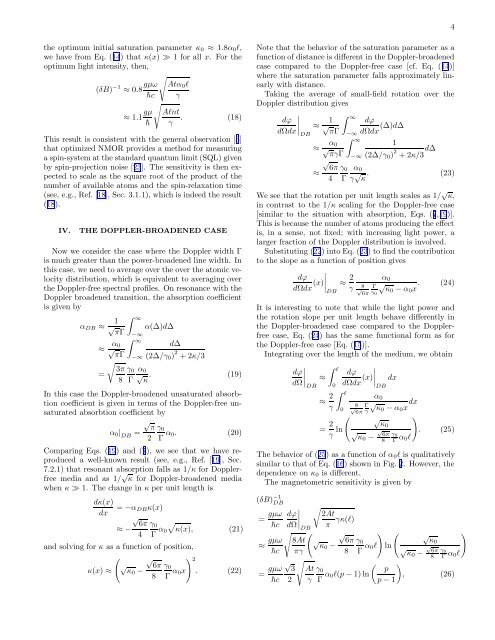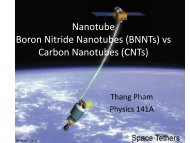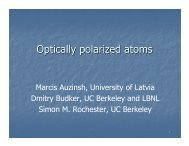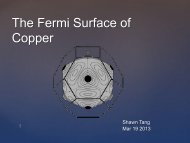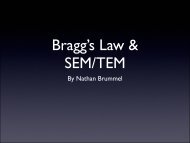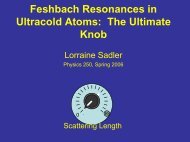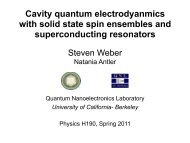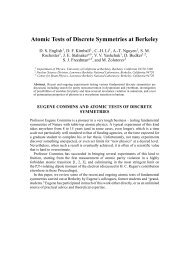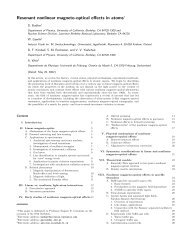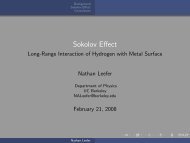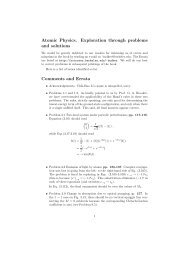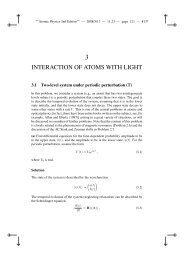Nonlinear magneto-optical rotation in optically thick media
Nonlinear magneto-optical rotation in optically thick media
Nonlinear magneto-optical rotation in optically thick media
Create successful ePaper yourself
Turn your PDF publications into a flip-book with our unique Google optimized e-Paper software.
4the optimum <strong>in</strong>itial saturation parameter κ 0 ≈ 1.8α 0 l,we have from Eq. (14) that κ(x) ≫ 1 for all x. For theoptimum light <strong>in</strong>tensity, then,√(δB) −1 ≈ 0.8 gµω Atα 0 l¯hc≈ 1.1 gµ¯hγ√Alntγ . (18)This result is consistent with the general observation [3]that optimized NMOR provides a method for measur<strong>in</strong>ga sp<strong>in</strong>-system at the standard quantum limit (SQL) givenby sp<strong>in</strong>-projection noise [23]. The sensitivity is then expectedto scale as the square root of the product of thenumber of available atoms and the sp<strong>in</strong>-relaxation time(see, e.g., Ref. [18], Sec. 3.1.1), which is <strong>in</strong>deed the result(18).IV.THE DOPPLER-BROADENED CASENow we consider the case where the Doppler width Γis much greater than the power-broadened l<strong>in</strong>e width. Inthis case, we need to average over the over the atomic velocitydistribution, which is equivalent to averag<strong>in</strong>g overthe Doppler-free spectral profiles. On resonance with theDoppler broadened transition, the absorption coefficientis given byα DB ≈ 1 √ πΓ∫ ∞−∞≈ α ∫ ∞0√ πΓ=√3π8γ 0Γ−∞α(∆)d∆d∆(2∆/γ 0 ) 2 + 2κ/3α 0√ κ. (19)In this case the Doppler-broadened unsaturated absorbtioncoefficient is given <strong>in</strong> terms of the Doppler-free unsaturatedabsorbtion coefficient by√ πα 0 | DB=2γ 0Γ α 0. (20)Compar<strong>in</strong>g Eqs. (19) and (7), we see that we have reproduceda well-known result (see, e.g., Ref. [19], Sec.7.2.1) that resonant absorption falls as 1/κ for Dopplerfree<strong>media</strong> and as 1/ √ κ for Doppler-broadened <strong>media</strong>when κ ≫ 1. The change <strong>in</strong> κ per unit length isdκ(x)dx= −α DBκ(x)√6π γ 0≈ −4 Γ α √0 κ(x), (21)and solv<strong>in</strong>g for κ as a function of position,( √ ) 2√ 6π γ 0κ(x) ≈ κ0 −8 Γ α 0x . (22)Note that the behavior of the saturation parameter as afunction of distance is different <strong>in</strong> the Doppler-broadenedcase compared to the Doppler-free case [cf. Eq. (14)]where the saturation parameter falls approximately l<strong>in</strong>earlywith distance.Tak<strong>in</strong>g the average of small-field <strong>rotation</strong> over theDoppler distribution givesdϕdΩdx∣ ≈ 1 ∫ ∞√DBπΓ −∞≈ α ∫ ∞0√ πγΓ≈√6π4γ 0Γ−∞dϕdΩdx (∆)d∆1(2∆/γ 0 ) 2 + 2κ/3 d∆α 0γ √ κ . (23)We see that the <strong>rotation</strong> per unit length scales as 1/ √ κ,<strong>in</strong> contrast to the 1/κ scal<strong>in</strong>g for the Doppler-free case[similar to the situation with absorption, Eqs. (7,19)].This is because the number of atoms produc<strong>in</strong>g the effectis, <strong>in</strong> a sense, not fixed; with <strong>in</strong>creas<strong>in</strong>g light power, alarger fraction of the Doppler distribution is <strong>in</strong>volved.Substitut<strong>in</strong>g (22) <strong>in</strong>to Eq. (23) to f<strong>in</strong>d the contributionto the slope as a function of position givesdϕdΩdx (x) ∣ ∣∣∣DB≈ 2 γα 08 √6πΓγ 0√κ0 − α 0 x . (24)It is <strong>in</strong>terest<strong>in</strong>g to note that while the light power andthe <strong>rotation</strong> slope per unit length behave differently <strong>in</strong>the Doppler-broadened case compared to the Dopplerfreecase, Eq. (24) has the same functional form as forthe Doppler-free case [Eq. (15)].Integrat<strong>in</strong>g over the length of the medium, we obta<strong>in</strong>∫dϕl∣ dϕ ∣∣∣DBdΩ∣ ≈DBdΩdx (x) dx≈ 2 γ0∫ l0√8Γ6π γα 0√κ0 − α 0 x dx(= 2 √γ ln κ0√κ0 − √ 6π γ 0Γ8α 0 l). (25)The behavior of (25) as a function of α 0 l is qualitativelysimilar to that of Eq. (16) shown <strong>in</strong> Fig. 2. However, thedependence on κ 0 is different.The <strong>magneto</strong>metric sensitivity is given by(δB) −1DB= gµω¯hc≈ gµω¯hc= gµω¯hc√dϕ2AtdΩ∣ DBπ γκ(l)√8Atπγ√ √32( √ ) ( √ )√ 6π γ 0κ0 −8 Γ α κ00l ln √κ0 − √ 6π γ 0Γ8α 0 l( )At γ 0pγ Γ α 0l(p − 1) ln , (26)p − 1


